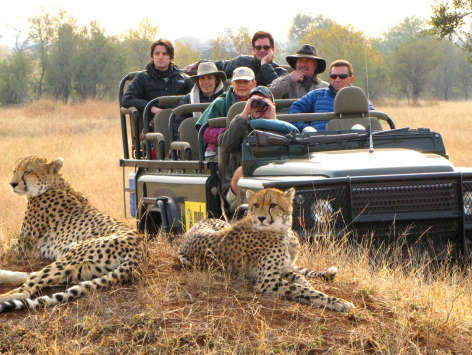Jawai Experience: Where Leopards Roam Among Shepherds
Jawai is not a national park—it’s a unique ecosystem where wildlife coexists with local communities.


Unlike traditional sanctuaries, Jawai is not a national park—it’s a unique ecosystem where wildlife coexists with local communities. Here, leopards live freely among the Rabari shepherds, who consider them sacred. There are no fences, no artificial boundaries. Just granite hills, caves, scrublands, and a deep-rooted trust between man and beast.
Safari drives are conducted in open 4x4 jeeps, guided by local experts who seem to know every twist and turn of the terrain. Mornings and evenings are the best times to head out, as leopards are most active then. I still remember the thrill of spotting a female leopard perched on a boulder at sunrise, her eyes gleaming in the golden light—pure magic.
The Jawai Dam area also attracts a rich variety of birdlife, including flamingos, cranes, and bar-headed geese during winter. If you’re lucky, you might even spot crocodiles lazing by the waterbanks. The region isn’t just about leopards; it’s a whole ecosystem waiting to be explored.
When to Visit Jawai: Seasons of Sightings
The best time to visit Jawai is between October and March, when the weather is pleasant and animal activity is higher. Winters bring cooler mornings and evenings, ideal for safaris. From April to June, the temperatures soar, but sightings remain fairly good as animals stay closer to water sources. However, accommodations during summer often shut down by mid-June due to the intense heat.
Monsoons (July–September) are generally avoided by tourists, but the lush greenery and cloud-draped hills do offer a different, more poetic charm—though leopard sightings become rarer.
My personal recommendation? Go in late November or early February for a perfect blend of weather and wildlife.
How to Reach Jawai: Remote but Accessible
Though it feels like the middle of nowhere, Jawai is surprisingly accessible. The nearest major town is Pali, and from there, it’s just about an hour's drive to the safari camps.
By Train: The closest railway station is Jawai Bandh, which is well connected via Jaipur, Jodhpur, and Ahmedabad. I took an overnight train from Jaipur and reached fresh in the morning—an ideal option if you want to save on travel time.
By Air: The nearest airports are Udaipur (145 km) and Jodhpur (165 km). You can easily book a cab from either airport. Some high-end resorts also offer pickup services.
By Road: Jawai is well connected by road to major cities in Rajasthan and Gujarat. A self-drive from Udaipur or Jodhpur takes about 3 to 4 hours.
Pro tip: The last stretch of road is through rural areas, so keep offline maps handy. Network coverage can be spotty.
Where to Stay: Luxury Meets Wilderness
One of the highlights of my Jawai trip was the stay itself. The region offers a range of boutique camps, eco-resorts, and luxury tented accommodations—each offering stunning views of the wilderness, often just steps away from leopard territory.
Top picks include:
Suján Jawai – Ultra-luxury, known for its sustainability and top-notch hospitality. If budget is not a constraint, this is an experience in itself.
Jawai Leopard Safari Lodge – Mid-range but comfortable, with a strong local vibe and personalized safari experiences.
Thour Nature Resorts – Budget-friendly yet beautiful, especially good for families or first-time safari-goers.
Most stays include meals, two safari drives per day, and a local village walk. I highly recommend interacting with the Rabari shepherds—their stories and way of life add deep cultural context to the trip.
Suggested Itinerary: A 2-Day Immersive Experience
Day 1: Arrival and First Safari Arrive in Jawai by noon, settle into your camp, and enjoy a traditional Rajasthani lunch. Post a quick rest, gear up for your first evening safari. With luck, you might spot a leopard emerging from its rocky hideout. Return to the camp for a bonfire dinner under the stars.
Day 2: Morning Safari and Local Exploration Wake up early for a sunrise safari—this is prime time for wildlife activity. After breakfast, take a guided walk through the nearby Rabari villages or visit the Jawai Dam for birdwatching. Head back for lunch, relax, and if staying longer, opt for another evening drive.
Two days are usually enough to absorb the essence of Jawai, though wildlife lovers often extend for a third day for more sightings.
Essential Tips: Travel Smart, Travel Safe
Pack smart: Neutral-colored clothes, good walking shoes, sunscreen, and binoculars. The sun can be harsh even in winter.
Stay quiet during safaris: The more discreet you are, the better your chances of sightings.
Don’t expect guaranteed leopard views: Remember, this is not a zoo. Respect the unpredictability.
Support local: Buy handmade souvenirs or dairy products from Rabari families—it contributes to conservation indirectly.
Travel insurance and first-aid: Always a good idea, especially in remote locations.
Budget-wise, a mid-range trip to Jawai (including stay, food, and safaris) can cost ₹10,000–₹18,000 per person per night. It’s pricier than your average rural getaway, but the exclusivity and authenticity are worth it.
Final Thoughts: Is Jawai Worth It?
Absolutely. Jawai isn’t just another stop on Rajasthan’s tourist trail—it’s a soulful journey into coexistence, raw nature, and quiet luxury. Whether you’re a wildlife photographer, a solo traveler seeking stillness, or a couple looking for a unique escape, Jawai Leopard Safari offers an experience that’s rare, respectful, and real.
As I watched the sun dip behind those ancient granite hills on my last evening, I felt something shift inside. There’s something humbling about being in a place where nature still holds sway and humans are just guests. Jawai reminds you of that.
So, if you're craving a deeper connection with the wild, skip the crowds and follow the leopard’s trail to Jawai. It just might be the wild whisper your soul needs.
Leave a comment